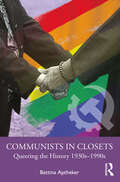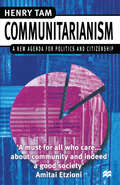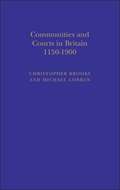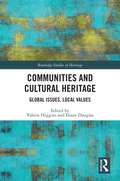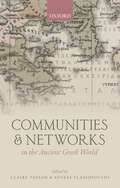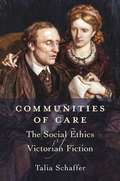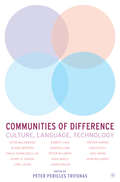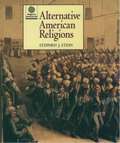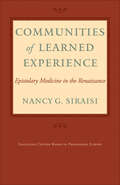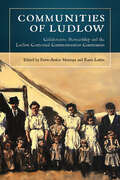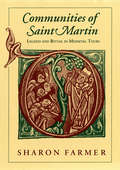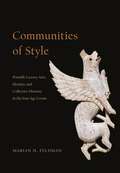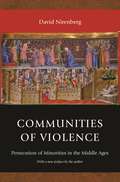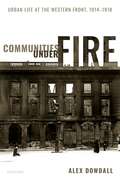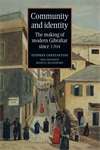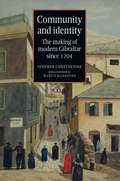- Table View
- List View
Communists in Closets: Queering the History 1930s–1990s
by Bettina ApthekerCommunists in Closets: Queering the History 1930s–1990s explores the history of gay, lesbian, and non-heterosexual people in the Communist Party in the United States. The Communist Party banned lesbian, gay, bisexual, and transgender (LGBT) people from membership beginning in 1938 when it cast them off as "degenerates." It persisted in this policy until 1991. During this 60-year ban, gays and lesbians who did join the Communist Party were deeply closeted within it, as well as in their public lives as both queer and Communist. By the late 1930s, the Communist Party had a membership approaching 100,000 and tens of thousands more people moved in its orbit through the Popular Front against fascism, anti-racist organizing, especially in the south, and its widely read cultural magazine, The New Masses. Based on a decade of archival research, correspondence, and interviews, Bettina Aptheker explores this history, also pulling from her own experience as a closeted lesbian in the Communist Party in the 1960s and ‘70s. Ironically, and in spite of this homophobia, individual Communists laid some of the political and theoretical foundations for lesbian and gay liberation and women’s liberation, and contributed significantly to peace, social justice, civil rights, and Black and Latinx liberation movements. This book will be of interest to students, scholars, and general readers in political history, gender studies, and the history of sexuality.
Communists in Closets: Queering the History 1930s–1990s
by Bettina ApthekerCommunists in Closets: Queering the History 1930s–1990s explores the history of gay, lesbian, and non-heterosexual people in the Communist Party in the United States. The Communist Party banned lesbian, gay, bisexual, and transgender (LGBT) people from membership beginning in 1938 when it cast them off as "degenerates." It persisted in this policy until 1991. During this 60-year ban, gays and lesbians who did join the Communist Party were deeply closeted within it, as well as in their public lives as both queer and Communist. By the late 1930s, the Communist Party had a membership approaching 100,000 and tens of thousands more people moved in its orbit through the Popular Front against fascism, anti-racist organizing, especially in the south, and its widely read cultural magazine, The New Masses. Based on a decade of archival research, correspondence, and interviews, Bettina Aptheker explores this history, also pulling from her own experience as a closeted lesbian in the Communist Party in the 1960s and ‘70s. Ironically, and in spite of this homophobia, individual Communists laid some of the political and theoretical foundations for lesbian and gay liberation and women’s liberation, and contributed significantly to peace, social justice, civil rights, and Black and Latinx liberation movements. This book will be of interest to students, scholars, and general readers in political history, gender studies, and the history of sexuality.
Communitarianism: A New Agenda for Politics and Citizenship
by Henry TamAlthough Communitarianism has a long history, it is only recently that it has emerged to pose a major challenge to the traditional left-right divide in politics and the competing principles of individualism and collectivism. Henry Tam's book provides a broad-ranging and accessible introduction to communitarian ideas and their implications for politics and citizenship drawing on a wide range of international examples and engaging with communitarianism's critics to demonstrate clearly its relevance beyond the United States base of many of its major protagonists.
Communities and Courts in Britain, 1150-1900
by Christopher BrooksThe essays in Communities and Courts in Britain, 1150-1900 all reflect the wider concept of legal history - how legal processes fitted into the social and political life of the community and how courts and other legal processes were used by contemporaries. In doing so they aim both to justify the study of legal history in its own right and to show how legal records, including those of a variety of central and local courts, can be used to further our understanding of a wide range of social, commercial, popular and political history.
Communities and Cultural Heritage: Global Issues, Local Values
by Valerie HigginsCommunities and Cultural Heritage explores the relationship between communities, their cultural heritage and the global forces that control most of the world’s wealth and resources in today’s world. Bringing together scholars and heritage practitioners from nine countries, this book contributes to the ongoing dialogue on community heritage by analysing impediments to full community participation. The underminin of local communities comes at a high price. As the chapters in this book demonstrate, the knowledge embedded within traditional and Indigenous heritage creates communities that are more resilient to environmental and social stressors and more responsive to contemporary challenges such as climate change, environmental degradation, post-disaster recovery and relocation. Cultural heritage practices often fail to capitalise upon local knowledge and traditional skills and undervalue the potential contribution of local communities in finding creative and resourceful solutions to the issues they are confronting. Arguing that the creation of successful community heritage project requires ongoing reflection on the aims, methods, financing and acceptable outcomes of projects, the volume also demonstrates that the decolonization of Western-focussed heritage practices is an ongoing process, by which subaltern groups are brought forward and given a space in the heritage narrative. Reflecting on trends that impact communities and heritage sites across different geographical regions, Communities and Cultural Heritage will be of interest to academics, students and practitioners of cultural heritage,archaeology and anthropology around the world.
Communities and Cultural Heritage: Global Issues, Local Values
by Valerie Higgins Diane DouglasCommunities and Cultural Heritage explores the relationship between communities, their cultural heritage and the global forces that control most of the world’s wealth and resources in today’s world. Bringing together scholars and heritage practitioners from nine countries, this book contributes to the ongoing dialogue on community heritage by analysing impediments to full community participation. The underminin of local communities comes at a high price. As the chapters in this book demonstrate, the knowledge embedded within traditional and Indigenous heritage creates communities that are more resilient to environmental and social stressors and more responsive to contemporary challenges such as climate change, environmental degradation, post-disaster recovery and relocation. Cultural heritage practices often fail to capitalise upon local knowledge and traditional skills and undervalue the potential contribution of local communities in finding creative and resourceful solutions to the issues they are confronting. Arguing that the creation of successful community heritage project requires ongoing reflection on the aims, methods, financing and acceptable outcomes of projects, the volume also demonstrates that the decolonization of Western-focussed heritage practices is an ongoing process, by which subaltern groups are brought forward and given a space in the heritage narrative. Reflecting on trends that impact communities and heritage sites across different geographical regions, Communities and Cultural Heritage will be of interest to academics, students and practitioners of cultural heritage,archaeology and anthropology around the world.
Communities and Networks in the Ancient Greek World
This volume examines the diversity of networks and communities in the classical and early Hellenistic Greek world, with particular emphasis on those which took shape within and around Athens. In doing so it highlights not only the processes that created, modified, and dissolved these communities, but shines a light on the interactions through which individuals with different statuses, identities, levels of wealth, and connectivity participated in ancient society. By drawing on two distinct conceptual approaches, that of network studies and that of community formation, Communities and Networks in the Ancient Greek World showcases a variety of approaches which fall under the umbrella of 'network thinking' in order to move the study of ancient Greek history beyond structuralist polarities and functionalist explanations. The aim is to reconceptualize the polis not simply as a citizen club, but as one inter-linked community amongst many. This allows subaltern groups to be seen not just as passive objects of exclusion and exploitation but active historical agents, emphasizes the processes of interaction as well as the institutions created through them, and reveals the interpenetration between public institutions and private networks which integrated different communities within the borders of a polis and connected them with the wider world.
Communities of Care: The Social Ethics of Victorian Fiction
by Talia SchafferWhat we can learn about caregiving and community from the Victorian novelIn Communities of Care, Talia Schaffer explores Victorian fictional representations of care communities, small voluntary groups that coalesce around someone in need. Drawing lessons from Victorian sociality, Schaffer proposes a theory of communal care and a mode of critical reading centered on an ethics of care.In the Victorian era, medical science offered little hope for cure of illness or disability, and chronic invalidism and lengthy convalescences were common. Small communities might gather around afflicted individuals to minister to their needs and palliate their suffering. Communities of Care examines these groups in the novels of Jane Austen, Charlotte Brontë, Charles Dickens, George Eliot, Henry James, and Charlotte Yonge, and studies the relationships that they exemplify. How do carers become part of the community? How do they negotiate status? How do caring emotions develop? And what does it mean to think of care as an activity rather than a feeling? Contrasting the Victorian emphasis on community and social structure with modern individualism and interiority, Schaffer’s sympathetic readings draw us closer to the worldview from which these novels emerged. Schaffer also considers the ways in which these models of carework could inform and improve practice in criticism, in teaching, and in our daily lives.Through the lens of care, Schaffer discovers a vital form of communal relationship in the Victorian novel. Communities of Care also demonstrates that literary criticism done well is the best care that scholars can give to texts.
Communities of Care: The Social Ethics of Victorian Fiction
by Talia SchafferWhat we can learn about caregiving and community from the Victorian novelIn Communities of Care, Talia Schaffer explores Victorian fictional representations of care communities, small voluntary groups that coalesce around someone in need. Drawing lessons from Victorian sociality, Schaffer proposes a theory of communal care and a mode of critical reading centered on an ethics of care.In the Victorian era, medical science offered little hope for cure of illness or disability, and chronic invalidism and lengthy convalescences were common. Small communities might gather around afflicted individuals to minister to their needs and palliate their suffering. Communities of Care examines these groups in the novels of Jane Austen, Charlotte Brontë, Charles Dickens, George Eliot, Henry James, and Charlotte Yonge, and studies the relationships that they exemplify. How do carers become part of the community? How do they negotiate status? How do caring emotions develop? And what does it mean to think of care as an activity rather than a feeling? Contrasting the Victorian emphasis on community and social structure with modern individualism and interiority, Schaffer’s sympathetic readings draw us closer to the worldview from which these novels emerged. Schaffer also considers the ways in which these models of carework could inform and improve practice in criticism, in teaching, and in our daily lives.Through the lens of care, Schaffer discovers a vital form of communal relationship in the Victorian novel. Communities of Care also demonstrates that literary criticism done well is the best care that scholars can give to texts.
Communities of Difference: Culture, Language, Technology
by P. TrifonasThis book will look at the implications of educational practices in communities that are differentiated by issues of language, culture, and technology. Trifonas argues that a 'community' is at once a gathering of like-minded individuals in solidarity of purpose and conviction, and also a gathering that excludes others. The chapters in this collection will reveal this tension between theory and practice in order to engage the models of community and the theories of difference that support them as a way to teach, to learn, and to know.
Communities of Dissent: A History of Alternative Religions in America
by Stephen J. SteinAlternative religious groups have had a profound influence on American history-they have challenged the old and opened up new ways of thinking about healing, modes of meaning, religious texts and liturgies, the social and political order, and the relationships between religion and race, class, gender, and region. Virtually always, the dramatic, dynamic history of alternative religions runs parallel to that of dissent in America. Communities of Dissent is an evenhanded and marvelously lively history of New Religious Movements in America. Stephen J. Stein describes the evolution and structure of alternative religious movements from both sides: the critics and the religious dissenters themselves. Providing a fascinating look at a wide range of New Religious Movements, he investigates obscure groups such as the 19th-century Vermont Pilgrims, who wore bearskins and refused to bathe or cut their hair, alongside better-known alternative believers, including colonial America's largest outsider faith, the Quakers; 17th- and 18th-century Mennonites, Amish, and Shakers; and the Christian Scientists, Jehovah's Witnesses, Black Muslims, and Scientologists of today. Accessible and comprehensive, Communities of Dissent also covers the milestones in the history of alternative American religions, from the infamous Salem witch trials and mass suicide/murder at Jonestown to the positive ways in which alternative religions have affected racial relations, the empowerment of women, and American culture in general.
Communities of Learned Experience: Epistolary Medicine in the Renaissance (Singleton Center Books in Premodern Europe)
by Nancy G. SiraisiDuring the Renaissance, collections of letters both satisfied humanist enthusiasm for ancient literary forms and provided the flexibility of a format appropriate to many types of inquiry. The printed collections of medical letters by Giovanni Manardo of Ferrara and other physicians in early sixteenth-century Europe may thus be regarded as products of medical humanism. The letters of mid- and late sixteenth-century Italian and German physicians examined in Communities of Learned Experience by Nancy G. Siraisi also illustrate practices associated with the concepts of the Republic of Letters: open and relatively informal communication among a learned community and a liberal exchange of information and ideas. Additionally, such published medical correspondence may often have served to provide mutual reinforcement of professional reputation. Siraisi uses some of these collections to compare approaches to sharing medical knowledge across broad regions of Europe and within a city, with the goal of illuminating geographic differences as well as diversity within social, urban, courtly, and academic environments. The collections she has selected include essays on general medical topics addressed to colleagues or disciples, some advice for individual patients (usually written at the request of the patient’s doctor), and a strong dose of controversy.
Communities of Learned Experience: Epistolary Medicine in the Renaissance (Singleton Center Books in Premodern Europe)
by Nancy G. SiraisiDuring the Renaissance, collections of letters both satisfied humanist enthusiasm for ancient literary forms and provided the flexibility of a format appropriate to many types of inquiry. The printed collections of medical letters by Giovanni Manardo of Ferrara and other physicians in early sixteenth-century Europe may thus be regarded as products of medical humanism. The letters of mid- and late sixteenth-century Italian and German physicians examined in Communities of Learned Experience by Nancy G. Siraisi also illustrate practices associated with the concepts of the Republic of Letters: open and relatively informal communication among a learned community and a liberal exchange of information and ideas. Additionally, such published medical correspondence may often have served to provide mutual reinforcement of professional reputation. Siraisi uses some of these collections to compare approaches to sharing medical knowledge across broad regions of Europe and within a city, with the goal of illuminating geographic differences as well as diversity within social, urban, courtly, and academic environments. The collections she has selected include essays on general medical topics addressed to colleagues or disciples, some advice for individual patients (usually written at the request of the patient’s doctor), and a strong dose of controversy.
Communities of Ludlow: Collaborative Stewardship and the Ludlow Centennial Commemoration Commission
by Fawn-Amber Montoya Karin LarkinFor more than one hundred years, people have come to the Ludlow Massacre Memorial site to remember the dead, to place themselves within a larger narrative of labor history, and to learn about what occurred there. Communities of Ludlow reveals the perseverance, memory, and work that has been done to enrich and share the narratives of the people of Ludlow and the experiences of those who commemorate it. The history of the Ludlow Massacre encompasses the stories of immigrant groups, women, the working-class, and people of color as much as the story of that tragedy, and the continued relevance of these issues creates a need for remembrance and discussion of how to make the events of the Ludlow Massacre available to contemporary society. The book outlines recent efforts to remember and commemorate this important historical event, documenting the unique collaborations in public scholarship and outreach among the diverse group of people involved in marking the 100-year anniversary of the Ludlow Massacre. The chapters relate the tales of the stewards of the Ludlow Massacre—the various communities that rallied together to keep this history alive and show its relevance, including lineal descendants, members of the United Mine Workers of America, historians, archaeologists, scholars, artists, interpreters, authors, playwrights, and politicians. The book also offers tips, strategies, and cautionary tales for practicing engaged public scholarship. The history of the Ludlow Massacre has been told as a tragedy of striking miners in the West that occurred during a turbulent time in US labor relations, but it is so much more than that. Communities of Ludlow explores the intersections of public scholarship, advocacy, and personal experience, weaving these perspectives together with models for practicing public scholarship to illustrate the power of creating spaces for sharing ideas and information in an environment that encourages creativity, open dialogue, public outreach, political action, and alternative narratives. Contributors: Robert Butero, Robin Henry, Michael Jacobson, Elizabeth Jameson, Linda Linville, Matthew Maher, Yolanda Romero
Communities of Saint Martin: Legend and Ritual in Medieval Tours
by Sharon FarmerSharon Farmer here investigates the ways in which three medieval communities—the town of Tours, the basilica of Saint-Martin there, and the abbey of Marmoutier nearby—all defined themselves through the cult of Saint Martin. She demonstrates how in the early Middle Ages the bishops of Tours used the cult of Martin, their fourthcentury predecessor, to shape an idealized image of Tours as Martin's town. As the heirs to Martin's see, the bishops projected themselves as the rightful leaders of the community. However, in the late eleventh century, she shows, the canons of Saint-Martin (where the saint's relics resided) and the monks of Marmoutier (which Martin had founded) took control of the cult and produced new legends and rituals to strengthen their corporate interests.Since the basilica and the abbey differed in their spiritualities, structures, and external ties, the canons and monks elaborated and manipulated Martin's cult in quite different ways. Farmer shows how one saint's cult lent itself to these varying uses, and analyzes the strikingly dissimilar Martins that emerged. Her skillful inquiry into the relationship between group identity and cultural expression illuminates the degree to which culture is contested territory.Farmer's rich blend of social history and hagiography will appeal to a wide range of medievalists, cultural anthropologists, religious historians, and urban historians.
Communities of Style: Portable Luxury Arts, Identity, and Collective Memory in the Iron Age Levant
by Marian H. FeldmanCommunities of Style examines the production and circulation of portable luxury goods throughout the Levant in the early Iron Age (1200–600 BCE). In particular it focuses on how societies in flux came together around the material effects of art and style, and their role in collective memory. Marian H. Feldman brings her dual training as an art historian and an archaeologist to bear on the networks that were essential to the movement and trade of luxury goods—particularly ivories and metal works—and how they were also central to community formation. The interest in, and relationships to, these art objects, Feldman shows, led to wide-ranging interactions and transformations both within and between communities. Ultimately, she argues, the production and movement of luxury goods in the period demands a rethinking of our very geo-cultural conception of the Levant, as well as its influence beyond what have traditionally been thought of as its borders.
Communities of Style: Portable Luxury Arts, Identity, and Collective Memory in the Iron Age Levant
by Marian H. FeldmanCommunities of Style examines the production and circulation of portable luxury goods throughout the Levant in the early Iron Age (1200–600 BCE). In particular it focuses on how societies in flux came together around the material effects of art and style, and their role in collective memory. Marian H. Feldman brings her dual training as an art historian and an archaeologist to bear on the networks that were essential to the movement and trade of luxury goods—particularly ivories and metal works—and how they were also central to community formation. The interest in, and relationships to, these art objects, Feldman shows, led to wide-ranging interactions and transformations both within and between communities. Ultimately, she argues, the production and movement of luxury goods in the period demands a rethinking of our very geo-cultural conception of the Levant, as well as its influence beyond what have traditionally been thought of as its borders.
Communities of Style: Portable Luxury Arts, Identity, and Collective Memory in the Iron Age Levant
by Marian H. FeldmanCommunities of Style examines the production and circulation of portable luxury goods throughout the Levant in the early Iron Age (1200–600 BCE). In particular it focuses on how societies in flux came together around the material effects of art and style, and their role in collective memory. Marian H. Feldman brings her dual training as an art historian and an archaeologist to bear on the networks that were essential to the movement and trade of luxury goods—particularly ivories and metal works—and how they were also central to community formation. The interest in, and relationships to, these art objects, Feldman shows, led to wide-ranging interactions and transformations both within and between communities. Ultimately, she argues, the production and movement of luxury goods in the period demands a rethinking of our very geo-cultural conception of the Levant, as well as its influence beyond what have traditionally been thought of as its borders.
Communities of Style: Portable Luxury Arts, Identity, and Collective Memory in the Iron Age Levant
by Marian H. FeldmanCommunities of Style examines the production and circulation of portable luxury goods throughout the Levant in the early Iron Age (1200–600 BCE). In particular it focuses on how societies in flux came together around the material effects of art and style, and their role in collective memory. Marian H. Feldman brings her dual training as an art historian and an archaeologist to bear on the networks that were essential to the movement and trade of luxury goods—particularly ivories and metal works—and how they were also central to community formation. The interest in, and relationships to, these art objects, Feldman shows, led to wide-ranging interactions and transformations both within and between communities. Ultimately, she argues, the production and movement of luxury goods in the period demands a rethinking of our very geo-cultural conception of the Levant, as well as its influence beyond what have traditionally been thought of as its borders.
Communities of Violence: Persecution of Minorities in the Middle Ages
by David NirenbergIn the wake of modern genocide, we tend to think of violence against minorities as a sign of intolerance, or, even worse, a prelude to extermination. Violence in the Middle Ages, however, functioned differently, according to David Nirenberg. In this provocative book, he focuses on specific attacks against minorities in fourteenth-century France and the Crown of Aragon (Aragon, Catalonia, and Valencia). He argues that these attacks--ranging from massacres to verbal assaults against Jews, Muslims, lepers, and prostitutes--were often perpetrated not by irrational masses laboring under inherited ideologies and prejudices, but by groups that manipulated and reshaped the available discourses on minorities. Nirenberg shows that their use of violence expressed complex beliefs about topics as diverse as divine history, kinship, sex, money, and disease, and that their actions were frequently contested by competing groups within their own society. Nirenberg's readings of archival and literary sources demonstrates how violence set the terms and limits of coexistence for medieval minorities. The particular and contingent nature of this coexistence is underscored by the book's juxtapositions--some systematic (for example, that of the Crown of Aragon with France, Jew with Muslim, medieval with modern), and some suggestive (such as African ritual rebellion with Catalan riots). Throughout, the book questions the applicability of dichotomies like tolerance versus intolerance to the Middle Ages, and suggests the limitations of those analyses that look for the origins of modern European persecutory violence in the medieval past.
Communities of Violence: Persecution of Minorities in the Middle Ages (PDF)
by David NirenbergIn the wake of modern genocide, we tend to think of violence against minorities as a sign of intolerance, or, even worse, a prelude to extermination. Violence in the Middle Ages, however, functioned differently, according to David Nirenberg. In this provocative book, he focuses on specific attacks against minorities in fourteenth-century France and the Crown of Aragon (Aragon, Catalonia, and Valencia). He argues that these attacks--ranging from massacres to verbal assaults against Jews, Muslims, lepers, and prostitutes--were often perpetrated not by irrational masses laboring under inherited ideologies and prejudices, but by groups that manipulated and reshaped the available discourses on minorities. Nirenberg shows that their use of violence expressed complex beliefs about topics as diverse as divine history, kinship, sex, money, and disease, and that their actions were frequently contested by competing groups within their own society. Nirenberg's readings of archival and literary sources demonstrates how violence set the terms and limits of coexistence for medieval minorities. The particular and contingent nature of this coexistence is underscored by the book's juxtapositions--some systematic (for example, that of the Crown of Aragon with France, Jew with Muslim, medieval with modern), and some suggestive (such as African ritual rebellion with Catalan riots). Throughout, the book questions the applicability of dichotomies like tolerance versus intolerance to the Middle Ages, and suggests the limitations of those analyses that look for the origins of modern European persecutory violence in the medieval past.
Communities under Fire: Urban Life at the Western Front, 1914-1918
by Alex DowdallBetween 1914 and 1918, the Western Front passed through some of Europe's most populated and industrialised regions. Large towns including Nancy, Reims, Arras, and Lens lay at the heart of the battlefield. Their civilian inhabitants endured artillery bombardment, military occupation, and material hardship. Many fled for the safety of the French interior, but others lived under fire for much of the war, ensuring the Western Front remained a joint civil-military space. Communities under Fire explores the wartime experiences of civilians on both sides of the Western Front, and uncovers how urban communities responded to the dramatic impact of industrialized war. It discusses how war shaped civilians' personal and collective identities, and explores how the experiences of military violence, occupation, and forced displacement structured the attitudes of civilians at the front towards the rest of the nation. Drawing on a vast array of archival sources, letters, diaries, and newspapers in English, French, and German, it reveals the history of the Western Front from the perspective of its civilian inhabitants. From Leningrad to Warsaw, Hamburg, and, more recently, Sarajevo and Donetsk, urban violence has remained a feature of warfare in Europe, turning cities into battlefields. On each occasion, civilian populations were at the heart of military operations, and forced to adapt to life in a warzone. This was also the case between 1914 and 1918, despite the myth that the First World War was predominantly a soldiers' war. The civilian inhabitants of the Western Front were among the first to suffer the full impact of modern, industrialized war in an urban setting. Communities under Fire explains the multiple ways by which these urban residents responded to, were changed by, succumbed to, or survived the enormous pressures of life in a warzone.
Communities under Fire: Urban Life at the Western Front, 1914-1918
by Alex DowdallBetween 1914 and 1918, the Western Front passed through some of Europe's most populated and industrialised regions. Large towns including Nancy, Reims, Arras, and Lens lay at the heart of the battlefield. Their civilian inhabitants endured artillery bombardment, military occupation, and material hardship. Many fled for the safety of the French interior, but others lived under fire for much of the war, ensuring the Western Front remained a joint civil-military space. Communities under Fire explores the wartime experiences of civilians on both sides of the Western Front, and uncovers how urban communities responded to the dramatic impact of industrialized war. It discusses how war shaped civilians' personal and collective identities, and explores how the experiences of military violence, occupation, and forced displacement structured the attitudes of civilians at the front towards the rest of the nation. Drawing on a vast array of archival sources, letters, diaries, and newspapers in English, French, and German, it reveals the history of the Western Front from the perspective of its civilian inhabitants. From Leningrad to Warsaw, Hamburg, and, more recently, Sarajevo and Donetsk, urban violence has remained a feature of warfare in Europe, turning cities into battlefields. On each occasion, civilian populations were at the heart of military operations, and forced to adapt to life in a warzone. This was also the case between 1914 and 1918, despite the myth that the First World War was predominantly a soldiers' war. The civilian inhabitants of the Western Front were among the first to suffer the full impact of modern, industrialized war in an urban setting. Communities under Fire explains the multiple ways by which these urban residents responded to, were changed by, succumbed to, or survived the enormous pressures of life in a warzone.
Community and identity: The making of modern Gibraltar since 1704 (PDF)
by Stephen ConstantineThis fluent, accessible and richly informed study, based on much previously unexplored archival material, concerns the history of Gibraltar following its military conquest in 1704, after which sovereignty of the territory was transferred from Spain to Britain and it became a British fortress and colony. Unlike virtually all other studies of Gibraltar, this book focuses on the civilian population. It shows how a substantial multi-ethnic Roman Catholic and Jewish population derived mainly from the littorals and islands of the Mediterranean became settled in British Gibraltar, much of it in defiance of British efforts to control entry and restrict residence. With Gibraltar’s political future still today contested this is a matter of considerable political importance. Community and identity: The making of modern Gibraltar since 1704 will appeal to both a scholarly and a lay readership interested particularly in the ‘Rock’ or more generally in nationality and identity formation, colonial administration, decolonisation and the Iberian peninsula.
Community and identity: The making of modern Gibraltar since 1704
by Stephen ConstantineThis fluent, accessible and richly informed study, based on much previously unexplored archival material, concerns the history of Gibraltar following its military conquest in 1704, after which sovereignty of the territory was transferred from Spain to Britain and it became a British fortress and colony. Unlike virtually all other studies of Gibraltar, this book focuses on the civilian population. It shows how a substantial multi-ethnic Roman Catholic and Jewish population derived mainly from the littorals and islands of the Mediterranean became settled in British Gibraltar, much of it in defiance of British efforts to control entry and restrict residence. With Gibraltar’s political future still today contested this is a matter of considerable political importance. Community and identity: The making of modern Gibraltar since 1704 will appeal to both a scholarly and a lay readership interested particularly in the ‘Rock’ or more generally in nationality and identity formation, colonial administration, decolonisation and the Iberian peninsula.
